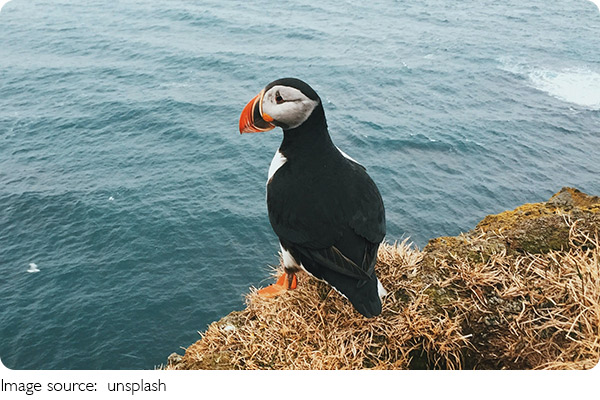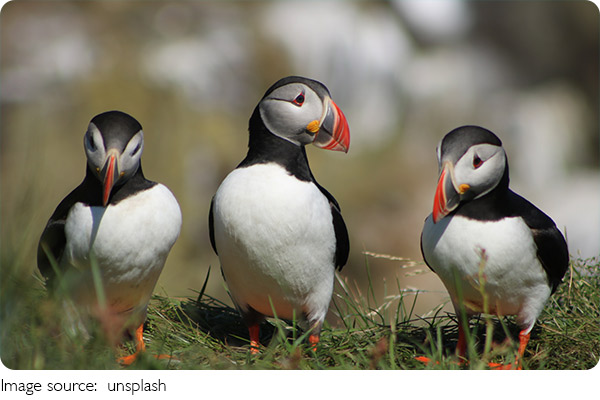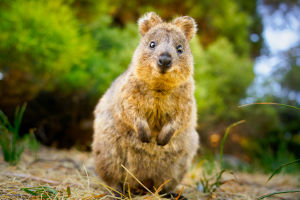Fly, Dive, Win

Ever heard of a bird that can fly, dive, and fish like a pro—all while looking absolutely adorable? Let's dive into the world of the Arctic puffin, a tiny but mighty bird living in the far, chilly North.
With its colorful beak, cute expressions, and incredible skills, this little seabird might just become our new favorite wildlife wonder.
Unique Looks That Steal the Show
When we spot an Arctic puffin up close, it's hard not to fall in love right away. They may only be around 10 to 15 inches (26–38 cm) long, but they pack a punch with their vibrant colors and lively personality. Their triangular beaks, which change color with the seasons, make them instantly recognizable. And let's not forget those bright orange feet that give them a cartoonish charm!
Their faces are framed by contrasting black and white feathers, with soft gray cheeks that make their expressions almost human-like—sometimes even a little goofy. Their beaks also tell their age, with visible growth rings, just like the rings in a tree trunk. If we ever get the chance to observe one up close, we might even be able to guess its age from those markings.
Born to Live on the Ocean
How do these small birds survive in the freezing Arctic seas? First off, their thick feathers act like high-performance insulation. Even in icy waters, they stay warm and dry underneath. Their bodies are built for tough environments, letting them dive and swim with ease.
Second, their feet are designed for the sea. Each toe is webbed—just like a duck's—allowing them to steer and change direction quickly underwater. They're not just paddling around; they're agile and efficient swimmers.
Third, while they are birds that can fly, their wings are short and powerful. This might seem like a disadvantage, but in fact, it's perfect for diving. Their rapid wing flaps work like underwater propulsion, helping them dart through the water just as smoothly as they soar through the sky.

The Ultimate Fishing Champion
Now here's the jaw-dropper: an Arctic puffin can catch and hold up to 62 small fish in one go. Yes, you read that right—62! Thanks to the design of their beaks and the sharp spines on the roof of their mouths, they can lock in their catch without dropping earlier fish. This gives them a huge advantage when feeding their young.
According to Dr. Aril Slotte, a specialist in North Atlantic marine trophic interactions:
"The Arctic puffin's record of securing 62 fish in a single foraging dive exemplifies extraordinary evolutionary adaptation. Their specialized beak morphology—featuring backward-facing spines on the palatal surface and a rasp-textured tongue—creates a unidirectional locking mechanism that prevents prey escape. This allows sequential fish capture without loss during underwater pursuit."
Speaking of parenting, puffins are extremely dedicated moms and dads. After a long hunt, they'll carry as many fish as they can back to their chicks. Since making multiple trips wastes time and increases risk from predators, storing all that food at once in their beaks is a smart and protective strategy.
Masters of the Sky, Too
Don't be fooled by their stubby wings—they can fly fast. Really fast. Puffins can reach speeds of up to 55 miles (88 kilometers) per hour. In the harsh conditions of the Arctic, this speed isn't just impressive—it's essential. When faced with danger, puffins have a unique trick: spiral flight. This rapid, spinning movement helps them dodge predators in a flash, giving them the upper hand in survival.
Why We Should Care
We might admire how freely puffins swim and fly, but their freedom is under threat. Their populations are declining due to predators and human activities. Pollution, overfishing, and habitat disturbance have made life harder for these beautiful creatures. That's why it's important for us to learn about them, respect their space, and protect the oceans they call home.
Let's Fly With the Puffins
Lykkers, the Arctic puffin isn't just a cute face—it's a tough, smart, and skilled survivor. From their fish-catching feats to their clever flying escapes, they've truly earned their spot in the spotlight. Isn't it amazing how much talent is packed into such a tiny bird?
Let's keep exploring nature's wonders together. Which animal should we discover next? Drop your thoughts, and we'll take the journey together. The world is full of stories just waiting to be told—and we're here to tell them.
Puffin Hunts Fish To Feed Puffling | Blue Planet II | BBC Earth
Video by BBC Earth
-
 Maladaptive Daydreaming!Stuck In Fantasies For Hours? What Is Maladaptive Daydreaming—And Why Can't Some People Snap Out?!
Maladaptive Daydreaming!Stuck In Fantasies For Hours? What Is Maladaptive Daydreaming—And Why Can't Some People Snap Out?! -
 Sarcopenia in Seniors!Why Are Seniors Losing Strength Fast?! Could This Hidden Muscle Loss Be Affecting Daily Life?!
Sarcopenia in Seniors!Why Are Seniors Losing Strength Fast?! Could This Hidden Muscle Loss Be Affecting Daily Life?! -
 Why Quokkas Always SmileThese friendly marsupials are more than cute selfies—here's what makes them so special!
Why Quokkas Always SmileThese friendly marsupials are more than cute selfies—here's what makes them so special!